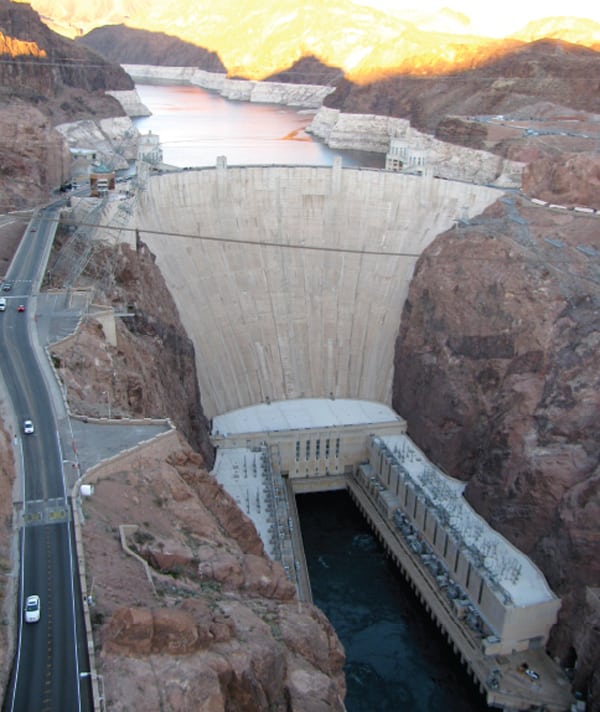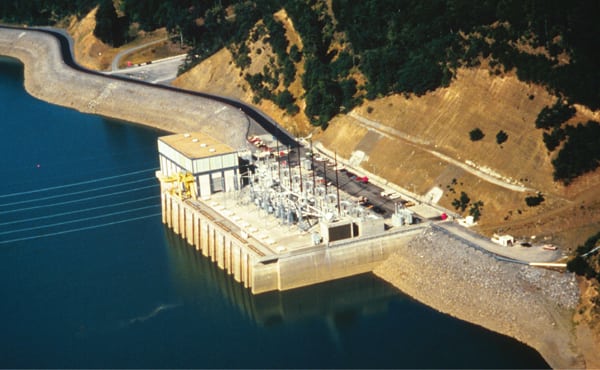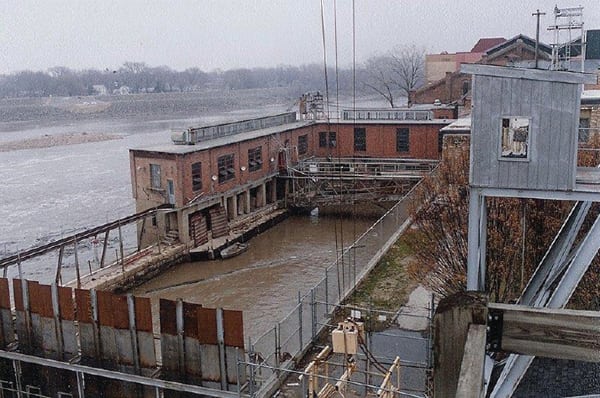Hydro: The Forgotten Renewable Rebounds
When President Obama unveiled his “clean energy standard” in the 2011 State of the Union address in February, and again when he spoke of his administration’s energy policy in late March, one form of electrical energy was conspicuous by its absence: hydropower. Hydro is the forgotten form, the politically incorrect renewable, the invisible generation. To borrow the complaint of comedian and Caddyshack movie star Rodney Dangerfield, hydro projects “don’t get no respect.”
Hydroelectric power, the oldest form of power on the planet, is a far more significant source of U.S. electricity than trendy technologies such as wind, sun, and heat from the Earth—combined. According to Energy Information Administration 2009 figures, hydro (conventional and pumped storage) provides 98.5 GW of nameplate generating capacity in the U.S. Wind, solar, wood, geothermal, and other biomass generation account for 51.6 GW of nameplate capacity.
Hydro requires no fossil fuels, emits no air pollution at all (including carbon dioxide), is reliable and dispatchable, works well in baseload or peaking modes, and provides valuable ancillary services such as frequency support. In short, hydro has all the operational characteristics of fossil plants but with the values we have come to associate with renewable generation.
But hydro has other attributes not associated with the au courant crowd of renewables. Hydro projects can provide flood control (Figure 1), drinking water, and recreational opportunities. It even can increase property values: Folks often pay a premium to live around hydro impoundments but often take a hit living near wind and solar energy farms.
 |
| 1. Shared services. Hoover Dam, located on the Colorado River at the border of Arizona and Nevada, is one of more than 600 dams and reservoirs operated by the Bureau of Reclamation, part of the U.S. Department of the Interior. One of the original motives for building the system of dams on the Colorado, which flows through seven western states and Mexico, was flood control. The 17 turbines in the Hoover Powerplant are rated at about 2,200 MW. The plant’s generation is shared among Arizona, California, and Nevada. Source: POWER |
Hydro power was also the first form of power that environmentalists learned to hate. It gobbles up large chunks of land, alters both land and water ecosystems, kills migratory fish, and presents engineers with safety challenges. John Muir created the Sierra Club to fight hydro in California’s high Sierra Nevadas. Dave Brower made the club famous 50 years later—and got himself fired—opposing hydro in the Grand Canyon (and supporting a nuclear project named Diablo Canyon). In 1988, the group that Brower hatched after his ejection from the Sierra Club—Friends of the Earth—launched a decades-long project to take down existing power dams in the hydro-rich Pacific Northwest.
Hydro Is Heavily Regulated
Historically, hydro politics and economics often have presaged the trials of nuclear power. Both were largely born of the federal government and continue to live by Uncle Sam’s largesse. Both gobble large amounts of capital up front but generate power cheaply once built. Both are heavily regulated by a central, independent federal agency—the U.S. Nuclear Regulatory Commission for the nukes and the Federal Energy Regulatory Commission (FERC) for water power. Both can suffer catastrophic accidents of low probability but large impact. Both represent enticing targets for terrorist attacks. Hydro, of course, got its baptism in controversy well before nuclear energy arrived on the generating scene.
But there are significant differences between the two generating technologies, primarily in scale. Whereas the image of hydro is the large concrete dam, such as the Bureau of Reclamation’s mammoth Hoover Dam on the Nevada/Arizona border, the reality is that small dams and projects predominate. Of the power dams that FERC regulates, more than 70% have a nameplate capacity below 5 MW.
And the scope of federal regulation of hydropower is far less extensive than the hold the government has on nuclear generation. FERC only regulates about half of the non-federal U.S. dams that generate power. The biggest, most visible dams tend to be those owned and operated by the federal government, including the Interior Department’s Bureau of Reclamation (Reclamation), the Army Corps of Engineers, and the Tennessee Valley Authority (TVA). Of the others, FERC generally approves licenses for projects that are on navigable waterways, are on federal land, or use surplus water from a federal dam.
According to the Oak Ridge National Laboratory (ORNL), licensed non-federal hydro projects today account for 57 GW of capacity from 4,370 projects (see sidebar). Federal hydro totals 41.9 GW from 746 projects. The Army Corps has 432 hydropower generating stations with 21.6 GW in capacity; Reclamation has 198 projects with 15.1 GW in capacity; TVA has 116 hydro worth 5.2 GW.
Although there has been plenty of public attention on the putative nuclear renaissance in recent years—“is it is or is it ain’t”—few think much about hydro these days. Yet water over the dam and through the turbine is staging its own renaissance of sorts, well below the radar. The hydro rebound appears to be slow and steady, far slower than its champions and developers would wish. But it is real nonetheless.
In 2007, FERC issued 10 hydro licenses, and nine were relicensed existing projects. In 2008, the agency issued 13 relicenses and four new licenses. By 2009, the scales had tilted toward new projects with eight relicensing decisions and 10 new licenses. In 2010, FERC issued six relicenses and six new licenses.
Since 2008, the agency has issued nearly 400 preliminary permits for potential licenses, most of them covering small projects. Preliminary permits are a means of queuing for a license. FERC explains on the licensing section of its website: “A preliminary permit, issued for up to three years, does not authorize construction; rather, it maintains priority of application for license (i.e., guaranteed first-to-file status) while the permittee studies the site and prepares to apply for a license.” Some 300 preliminary permit applications are pending at the commission.
FERC’s Jeff Wright, who heads the agency’s office of energy projects, told the Senate Energy and Natural Resources Committee in March, “In recent years, the commission has seen a greatly increased interest in small hydropower projects, in innovative hydrokinetic projects [Ed.: see “New York City Backs Tidal Power,” May 2011 in the POWER archives at https://www.powermag.com], and in pumped storage projects, particularly closed loop pumped storage, which does not involve regular water withdrawals from rivers or other water sources.”
More Pumped Storage Needed
The big, highly visible hydro projects these days are pumped storage projects, which use off-peak electricity to move water uphill so it can flow back down, generating power at periods of higher demand. These projects act like batteries. Though it is difficult and very expensive to store electricity, it is much easier and cheaper to store water and convert it into electricity.
Today, according to ORNL, pumped storage provides 20 GW of U.S. capacity. Forty-one projects are licensed by FERC, six are under review, and one has been proposed but is not yet in the regulatory process. The largest pumped storage project in the U.S. is Virginia’s Bath County station, at 2,772 MW (Figure 3). The project went into service in 1985, at a cost of $1.6 billion, following years of controversy. Because they are large and expensive, pumped storage projects often draw local fire, including opposition to the high-voltage power lines that are part of the package.
 |
| 3. Perfect peaking power. Virginia’s Bath County Pumped Storage Plant is jointly owned by “Dominion and the operating companies of the Allegheny Power System, and managed by Dominion Generation,” according to the Dominion website. The two reservoirs, one located 1,262 feet above the other, flow water to produce electricity using the plant’s six 462-MW turbines during periods of high electricity demand. The plant entered commercial service in 1985. Courtesy: VEPCO/Dominion Resources |
The slow but steady return of hydro to the menu of politically, environmentally, and economically respectable generation was on display in April in Washington at the annual meeting of the National Hydropower Association (NHA). The NHA is the lobbying and trade group for the water-to-watts crowd. What follows is some of the evidence for the return of hydro that emerged from that meeting.
Hydro Is Essential for RPS
States are beginning to look at ways to foster hydro developments in order to meet their renewable portfolio standards (RPS). The model is Colorado. Last summer the state signed a memorandum of understanding with FERC designed to streamline and speed up licensing of projects in that state that present a minimal environmental impact, such as generation from irrigation conduits, wastewater and industrial outflow, and projects under 5 MW in size.
Colorado in 2010 increased its renewable energy requirement from 20% to 30% by 2020. That goal probably can’t be met without new hydro. A study by the DOE’s Idaho National Laboratory found that Colorado has a potential for 1,400 MW of new hydro in projects of less than 5 MW. Under the agreement with FERC, the state is developing a pilot project to identify projects that qualify for streamlined federal review.
Colorado’s Francisco Flores told the NHA meeting, “The FERC process has not worked very well historically for small hydro.” Under the new deal with FERC, the state is working with the developers, the natural resource agencies, and investors to present a finished package to the federal regulators, short-stopping two steps out of three in the licensing process.
Congress is looking at new hydro legislation designed to boost conventional and unconventional waterpower technologies, including traditional terrestrial (S. 629) and new ocean-based approaches (S. 630) to making electricity. Sen. Lisa Murkowski (R-Alaska) told the NHA meeting that for her, as ranking minority member of the Senate Energy and Natural Resources Committee, and chairman Jeff Bingaman (D-N.M.), the bills are high priorities. Whether the rest of the Congress will also view hydro power as a priority is not clear. The Senate committee last year passed a comprehensive energy bill, with provisions boosting hydro, but it died far short of even getting to the Senate floor.
Murkowski told the group that the energy committee will probably avoid comprehensive, kitchen sink legislation this year and instead focus on discrete topics, such as hydro. But the Senate committee will also be looking over its shoulder at what’s happening in the other arm of Congress, where new spending and ramped up federal programs have far fewer friends. This year, she said, “We are often asking, ‘WWTHD’, what will the House do.”
The executive branch is putting some of its weakening financial muscle behind hydro. On the day of the NHA meeting—the timing was clearly intentional—the DOE and the Interior Department’s Bureau of Reclamation announced a joint program to put $26.6 million into funding innovative technologies that can “produce power more efficiently, reduce costs and increase sustainable hydropower generation at sites not previously considered practical.” The funds are aimed at:
- Small hydropower ($10.5 million awarded over three years). These projects will research, develop, and test low-head small hydropower technologies that can be quickly and efficiently deployed in existing or constructed waterways. The DOE will fund system or component model development, as well as the testing of these systems.
- Environmental mitigation technology for conventional hydropower ($2.25 million awarded over three years). These projects will develop innovative conventional hydropower technologies that feature designs to increase electricity generation while mitigating fish and habitat impacts and enhancing downstream water quality. The agencies are looking for ways to demonstrate turbine efficiencies greater than 90% and fish passage survival greater than 96%.
- Pumped storage ($11.875 million awarded over four years). The DOE wants to speed up pumped storage hydropower projects already in the pipeline. Projects that begin construction by 2014 and integrate wind or solar will get preference. The DOE will also support analyses that calculate the economic value of pumped storage hydropower in responding to the grid and in providing other ancillary services.
- Advanced conventional hydropower system testing at a Bureau of Reclamation facility ($2.0 million awarded over three years). These projects will support system tests of innovative, low-head hydropower technologies at non-powered Reclamation facilities and sites. The deliverables include testing to demonstrate energy cost reductions that could be replicated at other Reclamation sites. Both Reclamation and the DOE are sponsoring this work.
Much Hydro Remains Untapped
One reason hydro has been overlooked in recent years is the widespread notion that the resource is tapped out, that all the best rivers are dammed, all the opportunities used up. But that doesn’t appear to be the case. An ongoing ORNL analysis—the National Hydropower Asset Assessment Program (available at http://bit.ly/e15xeF), whose findings were unveiled at the NHA meeting in Washington—shows considerable opportunities for new hydro. The study identified a potential 12.6 GW of capacity available at 54,000 existing dams that don’t now have generating equipment. These potential projects are all greater than 1 MW in capacity.
The top 10 in ORNL’s potential greatest hits account for 3 GW of that total capacity. They are all Army Corps projects: four Ohio River dams, two Arkansas-Red River facilities, two on the Tombigbee River, and one each on the Mississippi and Alabama Rivers. The ORNL top 100 list totals 8 GW, with 81 Army Corps projects on the list. The potential hydro projects that ORNL discovered don’t represent threats to the environment. According to the report, “Most non-powered dams and potential capacity can be developed outside of critical habitat, parks, and wilderness areas.”
The potential hydro sites also solve a problem for states that want to enact or increase renewable energy quotas but don’t have sites that are sufficiently windy or sunny. ORNL notes, “Non-Powered Dam Potential exists in areas with less than ideal wind and solar resources.”
Separately, a Reclamation study released in March also finds a large potential opportunity for new hydro development in existing non-power water projects. The bureau surveyed its properties, finding 191 sites with hydro potential. Of those, it identified 43, representing potential generating capacity of 184.7 MW, with cost-benefit ratios greater than 1, meaning that a dollar investment would return benefits in excess of a dollar. Seven sites, with total capacity of 104.8 MW, had cost-benefit ratios higher than 2. The resource assessment concludes that “substantial hydropower potential exists at Reclamation sites. Some site analyses are based on over 20 years of hydrologic data that indicate a high likelihood of generation capability.”
Under-Hyped Hydro
It isn’t as high-profile as nuclear, it doesn’t get the respect it deserves (and neither did Rodney Dangerfield), but hydro looks as if it is making a comeback. And although the White House doesn’t appear to consider hydropower a renewable energy resource (it has not been mentioned in the list of generation technologies the administration considers “clean”) the executive branch agencies that deal with hydro view it as a realistic component in any renewable, allegedly clean, energy scheme.
It’s a good bet that any progress toward the administration’s goal of 80% of electricity from “clean” energy sources will include a hefty amount of water over a dam, through a pipe, down a hill, and into a turbine.
— Kennedy Maize is a contributing editor to POWER and executive editor of MANAGING POWER.
